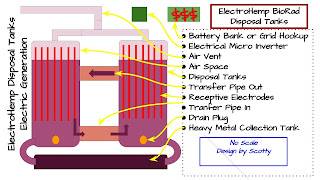An emerging technology for cleaning contaminated soils and shallow groundwater is phytoremediation, an environmentally friendly, low- cost, and low-tech process.
Phytoremediation encompasses all plant- influenced biological, chemical, and physical processes that aid in the uptake, degradation, and metabolism of contaminants by either plants or free-living organisms in the plant`s rhizosphere.
A phytoremediation system can be viewed as a biological, solar-driven, pump-and-treat system with an extensive, self-extending uptake network (the root system) that enhances the soil and below-ground ecosystem for subsequent productive use.
 |
| ElectroHemp BioRad Disposal Tanks |
Using Phytoremediation to Clean Up Contamination at Military Installations
During and following World War II, wastes from the production of munitions and other military materials were disposed of using the best available practices acceptable at that time. However, these disposal methods often contaminated soil and groundwater with organic compounds and metals that require cleanup under current regulations. An emerging technology for cleaning contaminated soils and shallow groundwater is phytoremediation, an environmentally friendly, low- cost, and low-tech process. Phytoremediation encompasses all plant- influenced biological, chemical, and physical processes that aid in the uptake, degradation, and metabolism of contaminants by either plants or free-living organisms in the plant`s rhizosphere. A phytoremediation system can be viewed as a biological, solar-driven, pump-and-treat system with an extensive, self-extending uptake network (the root system) that enhances the soil and below-ground ecosystem for subsequent productive use. Argonne National Laboratory (ANL) has been conducting basic and applied research in phytoremediation since 1990. Initial greenhouse studies evaluated salt-tolerant wetland plants to clean UP and reduce the volume of salty `produced water` from petroleum wells. Results of these studies were used to design a bioreactor for processing produced water that is being demonstrated at a natural gas well in Oklahoma; this system can reduce produced water volume by about 75% in less than eight days, representing substantial savings in waste disposal cost. During 1994, ANL conducted a TNT plant uptake and in situ remediation study in a ridge-and-furrow area used for the disposal of pink water at the Joliet Army Ammunition Plant.
SciTech Connect Conference: Using Phytoremediation to Clean Up Contamination at Military Installations
___________
http://www.osti.gov/scitech/servlets/purl/761921 pg 41:93
4.5 Regulatory Acceptance Current State Regulators are generally looking for a scientifically defensible basis for performance expectations. Results of bench-scale or greenhouse tests using site-specific soils are compelling evidence for predicting performance. It is also important to be realistic about the amount of time required for cleanup, acknowledging where phytoremediation is being used as a long-term remediation approach. For long-term remediation, the cost-effectiveness of the approach may be a factor. In addition, it will be important to show the controls in place to protect both ecological and human receptors. The fate of the contaminants (e.g., mercury and the volatilization processes) should also be predicted. Regulators will be looking for contingency plans in case of failure of the proposed phytoremediation technology and the willingness of the end user to implement that alternate technology. It was suggested that we confirm predicted performance by conducting one to two year field studies. Such studies should be prepared to implement contingency remedies if field performance is inadequate to achieve cleanup goals in a reasonable timeframe. The potential for adverse impacts to ecological receptors should be addressed by B-12 conducting a screening risk assessment and by comparing predicted exposures to reference values in the literature. Gaps • Regulatory acceptance of phytoremediation technologies is a critical gap. • Meeting risk-based limits may require measures to limit exposure in addition to removing contamination. • It is not known whether the timeline for deployment of a phytoremediation technology matches DOE’s regulatory requirements for cleanup.
___________
http://www.osti.gov/scitech/servlets/purl/761921 pg 41:93
4.5 Regulatory Acceptance Current State Regulators are generally looking for a scientifically defensible basis for performance expectations. Results of bench-scale or greenhouse tests using site-specific soils are compelling evidence for predicting performance. It is also important to be realistic about the amount of time required for cleanup, acknowledging where phytoremediation is being used as a long-term remediation approach. For long-term remediation, the cost-effectiveness of the approach may be a factor. In addition, it will be important to show the controls in place to protect both ecological and human receptors. The fate of the contaminants (e.g., mercury and the volatilization processes) should also be predicted. Regulators will be looking for contingency plans in case of failure of the proposed phytoremediation technology and the willingness of the end user to implement that alternate technology. It was suggested that we confirm predicted performance by conducting one to two year field studies. Such studies should be prepared to implement contingency remedies if field performance is inadequate to achieve cleanup goals in a reasonable timeframe. The potential for adverse impacts to ecological receptors should be addressed by B-12 conducting a screening risk assessment and by comparing predicted exposures to reference values in the literature. Gaps • Regulatory acceptance of phytoremediation technologies is a critical gap. • Meeting risk-based limits may require measures to limit exposure in addition to removing contamination. • It is not known whether the timeline for deployment of a phytoremediation technology matches DOE’s regulatory requirements for cleanup.








No comments:
Post a Comment